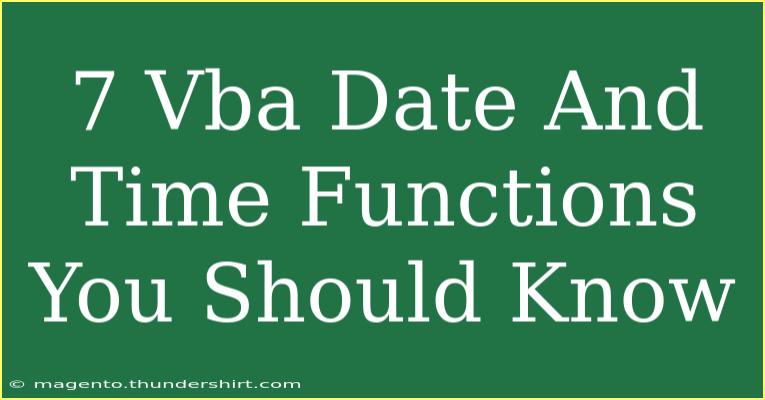When it comes to automating tasks in Excel, VBA (Visual Basic for Applications) can be a game changer. One of the most powerful aspects of VBA is its ability to manipulate date and time. Understanding how to use date and time functions not only helps you streamline your workflows but also allows you to make more informed decisions based on the data you’re working with. 🗓️ In this blog post, we will delve into 7 essential VBA date and time functions you should be familiar with, along with tips, shortcuts, common mistakes to avoid, and how to troubleshoot issues.
Understanding VBA Date and Time Functions
VBA provides a variety of functions for working with dates and times. Here are seven critical functions that can enhance your productivity:
1. Date
The Date function returns the current system date. It’s the most straightforward function, great for logging or referencing today's date.
Usage Example:
Sub GetCurrentDate()
MsgBox "Today's date is " & Date
End Sub
2. Time
Just like the Date function, the Time function retrieves the current system time. This function can be handy when you need to timestamp an action.
Usage Example:
Sub GetCurrentTime()
MsgBox "Current time is " & Time
End Sub
3. Now
The Now function combines both date and time, giving you the precise moment when the function is called.
Usage Example:
Sub GetCurrentDateTime()
MsgBox "Current date and time is " & Now
End Sub
4. DateAdd
The DateAdd function lets you add an interval to a date. This is useful for calculating future dates, such as deadlines or milestones.
Usage Example:
Sub AddDays()
Dim futureDate As Date
futureDate = DateAdd("d", 10, Date)
MsgBox "Date after 10 days: " & futureDate
End Sub
5. DateDiff
With the DateDiff function, you can calculate the difference between two dates. This can be useful for determining how many days are left until an important event.
Usage Example:
Sub CalculateDateDifference()
Dim daysDiff As Long
daysDiff = DateDiff("d", Date, DateAdd("d", 30, Date))
MsgBox "There are " & daysDiff & " days until the deadline."
End Sub
6. Format
The Format function allows you to change the appearance of dates and times. This can make reports more readable and visually appealing.
Usage Example:
Sub FormatDate()
MsgBox "Formatted date: " & Format(Date, "dd-mm-yyyy")
End Sub
7. Day, Month, Year
These three functions help you extract specific parts of a date, making it easier to perform calculations or make decisions based on those individual components.
Usage Example:
Sub ExtractDateComponents()
MsgBox "Day: " & Day(Date) & ", Month: " & Month(Date) & ", Year: " & Year(Date)
End Sub
Tips and Shortcuts for Using VBA Date and Time Functions
- Use Keyboard Shortcuts: Get familiar with the shortcuts for running macros (Alt + F8) to quickly execute your date and time functions.
- Combine Functions: You can combine these functions to create more complex operations, like calculating the number of workdays between two dates.
- Always Test Your Code: Test your functions in a sandbox environment to ensure they work as expected before applying them to important projects.
Common Mistakes to Avoid
- Ignoring Time Zones: If you’re working with data from different time zones, ensure you account for those when using
Now or Time.
- Using Wrong Date Formats: Be cautious with date formats, as different locales can cause errors in interpretation.
- Not Validating Inputs: Always validate your date inputs to avoid errors when performing calculations.
Troubleshooting Issues
- Error Messages: If you encounter errors, make sure that your input data is valid and in the correct format.
- Unexpected Results: Review your logic and ensure that your functions are applied correctly. Using the Immediate Window in the VBA editor can help you debug.
- Performance Issues: If your date calculations slow down your macros, look for ways to minimize the number of function calls, such as storing results in variables.
<div class="faq-section">
<div class="faq-container">
<h2>Frequently Asked Questions</h2>
<div class="faq-item">
<div class="faq-question">
<h3>How can I get the last day of the month using VBA?</h3>
<span class="faq-toggle">+</span>
</div>
<div class="faq-answer">
<p>You can use the DateAdd function along with Day to achieve this. For example:
DateAdd("d", -Day(Date), DateAdd("m", 1, Date)) will give you the last day of the current month.</p>
</div>
</div>
<div class="faq-item">
<div class="faq-question">
<h3>Can I calculate age using VBA date functions?</h3>
<span class="faq-toggle">+</span>
</div>
<div class="faq-answer">
<p>Yes! Use the DateDiff function to find the difference in years between a birthdate and the current date. For example:
DateDiff("yyyy", BirthDate, Now) will give you the age in years.</p>
</div>
</div>
<div class="faq-item">
<div class="faq-question">
<h3>What if my date is in a different format?</h3>
<span class="faq-toggle">+</span>
</div>
<div class="faq-answer">
<p>You can use the CDate function to convert a string to a date. Just ensure that the string is in a recognized format.</p>
</div>
</div>
<div class="faq-item">
<div class="faq-question">
<h3>How can I change the date format in Excel using VBA?</h3>
<span class="faq-toggle">+</span>
</div>
<div class="faq-answer">
<p>Use the NumberFormat property of a range to set the date format. For example:
Range("A1").NumberFormat = "dd-mm-yyyy" will format the date in cell A1.</p>
</div>
</div>
</div>
</div>
Having a grasp of these seven VBA date and time functions can empower you to handle tasks with ease and efficiency. By applying the tips and advice given in this post, you can make the most out of your date and time functions. Remember to keep practicing! Explore related tutorials and challenges to strengthen your VBA skills further.
<p class="pro-note">💡Pro Tip: Don't hesitate to dive into the VBA help documentation for even more advanced date and time functions! Explore and enhance your automation abilities!</p>
